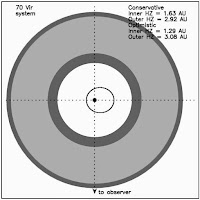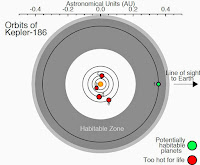In the past two decades
over a thousand planets have been found orbiting stars other than our
own, many of which appear to be small rocky planets in the habitable
zones of their stars (i.e. the zone in which such a planet might host
liquid water, thought to be an essential precursor for life). The
Transiting Exoplanet Survey Satellite, due for launch in 2017, is
intended to look for Earth-like planets around nearby stars. To do
this it will look for biomarkers, chemical signs thought to be
indicative of life, in the atmospheres of any planets that it finds.
One of the most obvious such biomarkers to look for would be
molecular oxygen (O2) which makes up 20% of the atmosphere
on Earth, and which is thought to be entirely produced by the actions
of photosynthetic Bacteria, Algae and Plants.
However in order to be
sure that such biomarkers are genuine signs of life, scientists need
to be confident that they could not be formed in other, abiotic ways.
Oxygen, for example, can also be formed by photodissociation of water
molecules (H2O) by ultraviolet light, and therefore could
potentially make up a high proportion of the atmosphere of planets
that receive high amounts of such radiation. Large amounts of
ultraviolet light are also though to be extremely harmful to life, so
that such planets could probably be ruled out of any search for life
quite easily, but the potential remains that free oxygen could be
produced in other, less easily detectable ways.
An artist's impression of the planned Transiting Exoplanet Survey Satellite. NASA.
In a paper published in
the journal Nature Scientific Reports on 10 September 2015, Norio Narita of the Astrobiology Center at the National Institutes ofNatural Sciences in Tokyo, the National Astronomical Observatory of Japan and the Graduate University for Advanced Studies, Takafumi
Enomoto and Shigeyuki Masaoka of the Graduate University for
Advanced Studies and the Institute for Molecular Science, and
Nobuhiko Kusakabe, also of the National Astronomical Observatory of
Japan describe a process by which rocky planets could potentially
develop atmospheres containing substantial levels of oxygen without
photosynthetic organisms or exposure to high levels of ultraviolet
radiation.
Narita et al. observe
that the mineral titania (a form of titanium dioxide, TiO2),
can act as a catalyst for the photodissociation of water molecules by
light at near-ultraviolet wavelengths (280-400nm). They further note
that the mineral appears to be common in the universe, having been
detected in dust outflows around giant stars and supernovas as well
as on the Moon and other bodies in the Solar System. Substantial
amounts of exposed titania on the surface of a planet with water in
its atmosphere could potentially lead to a build-up of molecular
oxygen in the atmosphere of the planet.
SEM image of the surface of a grain of titania. Tong et al. (2015).
Narita et al.
calculate that were the Earth's
surface to be covered by titania, and that levels of near-ultraviolet
radiation measured at the Hateruma Observatory between 2000 and 2014
are typical for Earth over a longer period then the level of oxygen
seen in our atmosphere could be produced in about 20 000 years, and
the all the water in the Earth's oceans could potentially be
photodissociated within 20 000 000 years, though they calculate that
the amount of exposed titania at the Earth's surface is actually less
than 250 km2.
From
these calculations Narita et al. conclude
that it would be possible for an Earth-like planet orbiting a
Sun-like star to develop levels of molecular oxygen in its atmosphere
similar to those seen on Earth through the catalytic action of
titania without the presence of any form of life.
Next
Narita et al. examined the possibility of the titania process
creating oxygen-rich atmospheres around Earth-like planets orbiting
non-Sun-like stars. They modelled Earth-like planets around a series
of hypothetical stars; an M6 Red Dwarf star with an effective surface
temperature of 3000K (compared to 5778K for the Sun), a
radius 15% of that of the Sun, a luminosity 0.09% of the Sun's and an
Earth-like planet orbiting at a distance of 0.03 AU (3% of the
distance at which the Earth orbits the Sun); an M0 Red Dwarf with an
effective surface temperature of 3800K, a radius 50% of that of the
Sun, a luminosity 7.2% of that of the Sun and an Earth-like planet
orbiting at a distance of 0.27 AU; a K2 Orange Dwarf Star with an
effective surface temperature of 5000, a radius 73% of the Sun's, a
luminosity 33% of the Sun's and an Earth-like planet orbiting at 0.58
AU; and an F6 Yellow-white Dwarf star with an effective surface temperature of
6300K, a radius 150% of the Sun's, a luminosity three times that of
the Sun and an Earth-like planet orbiting at a distance of 1.73 AU.
In each case they found that an oxygen-rich atmosphere could
potentially be created by the titania catalyzed photolysis of water.
Narita
et al. caution that the formation of oxygen by the photolysis
of water will not automatically lead to the development of an
oxygen-rich atmosphere. On Earth photosynthetic organisms are thought
to have produced oxygen for millions of years before it began to
build up in the atmosphere, as free oxygen reacted with a variety of
substances present on the Earth's surface, most notably iron, and
only once these oxidisable substances had been used up beginning to
accumulate in the atmosphere, and as similar reactive substances are
likely to be present on any alien world, then titania would need be
present at the surface of the planet and suitable near-ultraviolet
radiation reach that surface, for long enough for all such reactions
to occur before oxygen began to accumulate in the atmosphere.
See
also...
 Determining the Habitable Zone of 70 Virginis. 70 Viriginis is a G-type Yellow Dwarf Star about 59 light years from Earth in the constellation of Virgo. It is
calculated to have a mass 109% of that of the Sun, but radius 194% of the
Sun’s, and a lower temperature, 5393K, compared to 5778K for the Sun, from
which it is calculated to be somewhat older, approximately 7.77 billion years
(compared to about 5.0 for the Sun)...
Determining the Habitable Zone of 70 Virginis. 70 Viriginis is a G-type Yellow Dwarf Star about 59 light years from Earth in the constellation of Virgo. It is
calculated to have a mass 109% of that of the Sun, but radius 194% of the
Sun’s, and a lower temperature, 5393K, compared to 5778K for the Sun, from
which it is calculated to be somewhat older, approximately 7.77 billion years
(compared to about 5.0 for the Sun)... Kepler 186f: an Earth-sized planet in the habitable zone of a Red Dwarf star. One of the key objectives in the search for planets orbiting other stars
has been to locate planets in the habitable zones of such stars, i.e.
planets on which liquid water could potentially exist. A number of
planets with habitable zone orbits have been described...
Kepler 186f: an Earth-sized planet in the habitable zone of a Red Dwarf star. One of the key objectives in the search for planets orbiting other stars
has been to locate planets in the habitable zones of such stars, i.e.
planets on which liquid water could potentially exist. A number of
planets with habitable zone orbits have been described...
Follow
Sciency Thoughs on Facebook.


